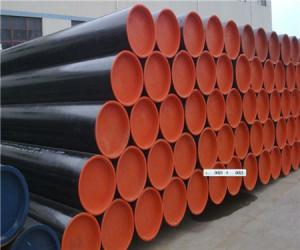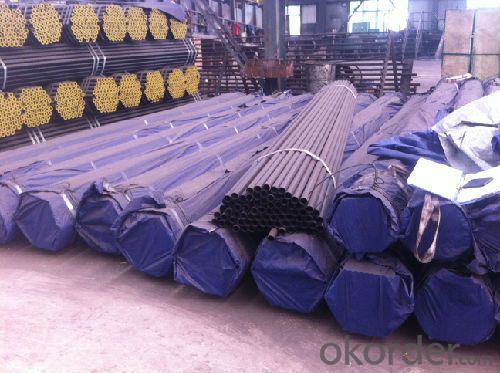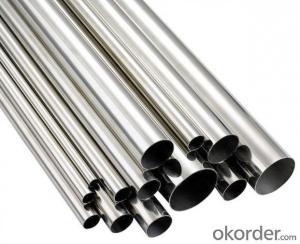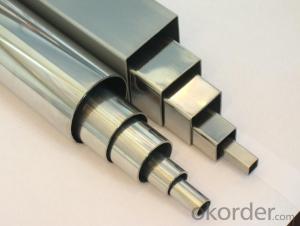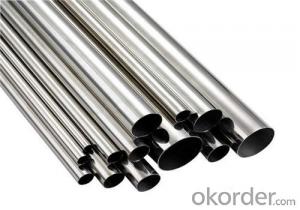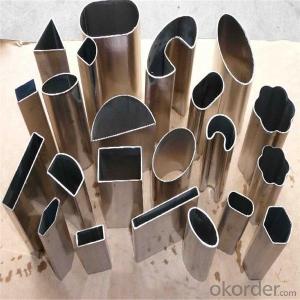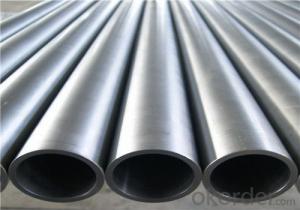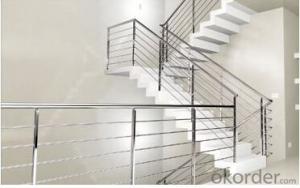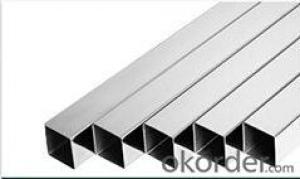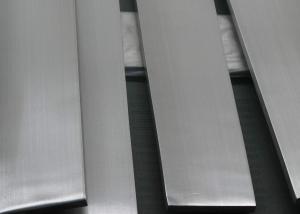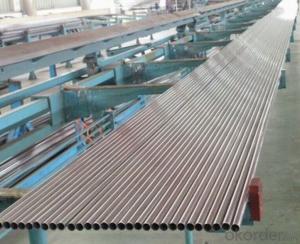Regular Stainless Steel Square Pipe 304,316,201 Supplier
- Loading Port:
- China Main Port
- Payment Terms:
- TT or LC
- Min Order Qty:
- 30 m.t.
- Supply Capability:
- 12000 m.t./month
OKorder Service Pledge
OKorder Financial Service
You Might Also Like
1、Structure of Seamless Pipe ASTM A106/53:
Seamless pipe is formed by drawing a solid billet over a piercing rod to create the hollow shell. As the manufacturing process does not include any welding, seamless pipes are perceived to be stronger and more reliable. Historically seamless pipe was regarded as withstanding pressure better than other types, and was often more easily available than welded pipe.
Packing and shipment
Packaged in bundles,as per customers' requirements, it can also bepackagesd as beveled ends, typed marking, black painting, plastic caps protection,woven bags packing
For 20" container the max length is 5.8m; For 40" container the max length is 12m. other options are available based on customer requests. Please discuss when placing orders.
2、Main Features of the Seamless Pipe ASTM A106/53:
• High manufacturing accuracy
• High strength
• Small inertia resistance
• Strong heat dissipation ability
• Good visual effect
• Reasonable price
3、Seamless Pipe ASTM A106/53 Specification:
Standard | GB, DIN, ASTM ASTM A106-2006, ASTM A53-2007 |
Grade | 10#-45#, 16Mn 10#, 20#, 45#, 16Mn |
Thickness | 8 - 33 mm |
Section Shape | Round |
Outer Diameter | 133 - 219 mm |
Place of Origin | Shandong, China (Mainland) |
Secondary Or Not | Non-secondary |
Application | Hydraulic Pipe |
Technique | Cold Drawn |
Certification | API |
Surface Treatment | factory state or painted black |
Special Pipe | API Pipe |
Alloy Or Not | Non-alloy |
Length | 5-12M |
Outer Diameter | 21.3-610mm |
Grade | 20#, 45#, Q345, API J55, API K55, API L80, API N80, API P110, A53B |
Standard | ASME, ASTM |
4、Packaging & Delivery
Packaging Details: | seaworthy package,bundles wrapped with strong steel strip |
Delivery Detail: | 15-30days after received 30%TT |
5、FAQ of Seamless Pipe ASTM A106/53:
①How is the quality of your products?
Our products are manufactured strictly according to national and internaional standard, and we take a test
on every pipe before delivered out. If you want see our quality certifications and all kinds of testing report, please just ask us for it.
Guaranteed: If products’ quality don’t accord to discription as we give or the promise before you place order, we promise 100% refund.
②How about price?
Yes, we are factory and be able to give you lowest price below market one, and we have a policy that “ for saving time and absolutely honest business attitude, we quote as lowest as possible for any customer, and discount can be given according to quantity”,if you like bargain and factory price is not low enough as you think, just don’t waste your time.Please trust the quotation we would give you, it is professional one.
③Why should you chose us?
Chose happens because of quality, then price, We can give you both.Additionally, we can also offer professional products inquiry, products knowledge train(for agents), smooth goods delivery, exellent customer solution proposals.Our service formula: good quality+good price+good service=customer’s trust
SGS test is available, customer inspection before shipping is welcome, third party inspection is no problem.
6、Seamless Pipe ASTM A106/53 Images:
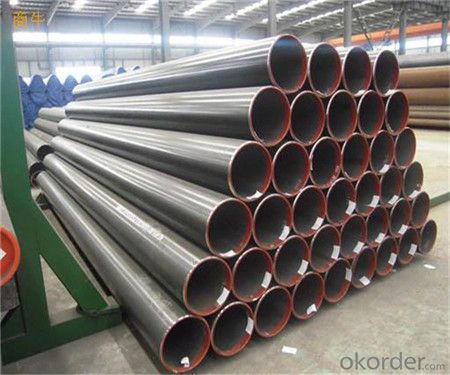
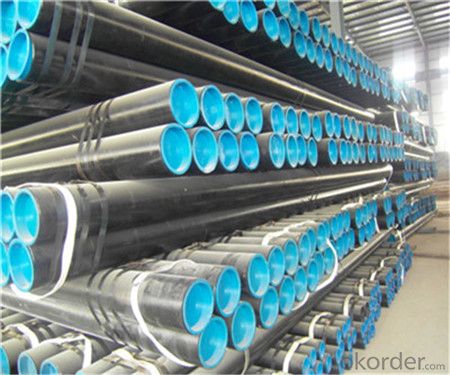
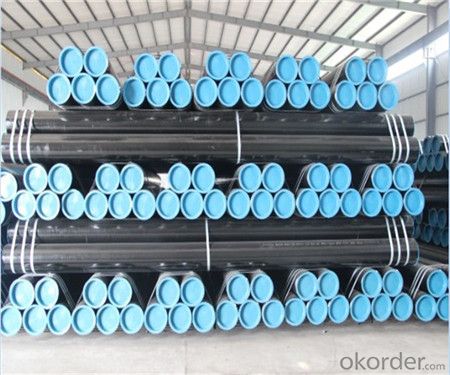
- Q: Can stainless steel pipes be used for air conditioning systems?
- Indeed, air conditioning systems can utilize stainless steel pipes. Given its durability and resistance to corrosion, stainless steel proves to be a fitting material for a wide range of applications, including air conditioning systems. With their exceptional resistance to oxidation and rust, stainless steel pipes guarantee prolonged use and ward off any potential leakage. Moreover, these pipes possess the capacity to withstand elevated temperatures and pressure, rendering them perfect for integration within air conditioning systems.
- Q: Can stainless steel pipes be insulated with polytetrafluoroethylene?
- Polytetrafluoroethylene (PTFE) is a high-performance polymer that is well-known for its exceptional thermal and chemical resistance. By insulating stainless steel pipes with PTFE, one can effectively prevent heat loss or gain and maintain the desired temperature of the fluid flowing through the pipes. This is particularly important in industries like chemical processing and food processing, where precise temperature control is crucial. Additionally, PTFE insulation serves as a protective barrier against condensation, preventing moisture accumulation on the pipe's surface. Moreover, PTFE's low friction coefficient enhances the flow of liquids through the pipes, reducing pressure drop and enhancing the overall efficiency of the system. Furthermore, PTFE exhibits excellent electrical insulation properties, making it ideal for applications where electrical conductivity must be avoided. In summary, PTFE is a dependable and efficient material for insulating stainless steel pipes, offering thermal, chemical, and electrical insulation properties, as well as corrosion resistance.
- Q: Can stainless steel pipes be used for drinking water supply?
- Yes, stainless steel pipes can be used for drinking water supply. Stainless steel is a highly durable and corrosion-resistant material, making it a suitable choice for transporting drinking water safely and hygienically. Unlike other materials, stainless steel pipes do not leach harmful chemicals or contaminants into the water, maintaining its quality and purity. Additionally, stainless steel pipes are resistant to bacterial growth, which further ensures the safety of the drinking water.
- Q: How do you prevent galvanic corrosion in stainless steel pipes?
- To prevent galvanic corrosion in stainless steel pipes, one can take several measures: 1. Ensure compatibility of materials: It is crucial to use compatible materials near stainless steel pipes to avoid galvanic corrosion. Avoid direct contact between stainless steel pipes and dissimilar metals like carbon steel, copper, or aluminum. 2. Insulate dissimilar metals: If it is necessary to have dissimilar metals in close proximity to stainless steel pipes, one can use electrical insulation. By electrically isolating the metals, the flow of electric current and subsequent galvanic corrosion can be minimized. 3. Apply protective coatings: Protective coatings like paint or epoxy can be applied to the external surface of stainless steel pipes. These coatings act as a barrier against galvanic corrosion by preventing direct contact between stainless steel and other metals that may cause galvanic reactions. 4. Use dielectric unions: When connecting stainless steel pipes to dissimilar metals, dielectric unions can be used to separate the metals and prevent galvanic corrosion. These unions incorporate insulating materials such as plastic or rubber to avoid direct contact between the metals. 5. Implement cathodic protection: Cathodic protection is an effective method to prevent galvanic corrosion in stainless steel pipes. By introducing a sacrificial anode like zinc or magnesium into the system, the anode corrodes instead of the stainless steel. Periodic replacement of the sacrificial anode ensures continuous protection. 6. Install corrosion-resistant alloys: If the application allows, using corrosion-resistant alloys like duplex stainless steel or titanium can provide enhanced protection against galvanic corrosion. These alloys have better resistance to galvanic reactions and are less prone to corrosion in various environments. Overall, a combination of these preventive measures can significantly reduce the risk of galvanic corrosion in stainless steel pipes, ensuring their longevity and performance. It is important to assess the specific application and environment to determine the most suitable preventive measures to be implemented.
- Q: How do you prevent galling in stainless steel pipes?
- One way to prevent galling in stainless steel pipes is by applying an anti-seize compound or lubricant to the threaded connections. This helps to reduce friction and prevents the surfaces from seizing together. Additionally, ensuring proper thread engagement and avoiding excessive tightening can also help prevent galling.
- Q: What is the maximum operating pressure for stainless steel pipes?
- The maximum operating pressure for stainless steel pipes can vary depending on various factors such as the grade of stainless steel, the pipe size, and the specific application. However, stainless steel pipes can typically handle operating pressures ranging from several hundred to several thousand pounds per square inch (psi). It is important to consult with industry standards, specific product specifications, and engineering guidelines to determine the maximum operating pressure for a particular stainless steel pipe.
- Q: What is the difference between seamless and double submerged arc welded stainless steel pipes?
- The main difference between seamless and double submerged arc welded stainless steel pipes lies in their production process. Seamless pipes are manufactured without any welding or seams, resulting in a smooth and continuous pipe with uniform strength throughout. On the other hand, double submerged arc welded pipes are created by welding two separate pieces of steel together using the submerged arc welding method. This creates a welded joint along the length of the pipe. While both types of pipes have their own advantages and applications, seamless pipes are generally preferred for their superior strength, durability, and resistance to corrosion.
- Q: What is the maximum operating temperature for stainless steel pipes?
- The maximum operating temperature for stainless steel pipes can vary depending on the specific grade of stainless steel being used. However, in general, stainless steel pipes are capable of withstanding high temperatures. Austenitic stainless steel grades, such as 304 and 316, can typically handle temperatures up to 870°C (1600°F). Meanwhile, ferritic stainless steel grades, such as 430, have a lower maximum operating temperature of around 760°C (1400°F). It is important to consult the manufacturer's specifications and guidelines to determine the specific maximum operating temperature for a particular stainless steel grade and pipe.
- Q: What are the different types of stainless steel pipe valves?
- There are several different types of stainless steel pipe valves, including ball valves, gate valves, globe valves, check valves, and butterfly valves. Each type of valve has its own unique design and function, catering to specific applications and requirements in various industries.
- Q: How do you calculate the weight of stainless steel pipes?
- To calculate the weight of stainless steel pipes, you need to know the outer diameter, wall thickness, and length of the pipe. Using these measurements, you can apply the formula: weight = (outer diameter - wall thickness) x wall thickness x length x density of stainless steel. The density of stainless steel is typically around 7.9 grams per cubic centimeter.
Send your message to us
Regular Stainless Steel Square Pipe 304,316,201 Supplier
- Loading Port:
- China Main Port
- Payment Terms:
- TT or LC
- Min Order Qty:
- 30 m.t.
- Supply Capability:
- 12000 m.t./month
OKorder Service Pledge
OKorder Financial Service
Similar products
Hot products
Hot Searches
Related keywords
